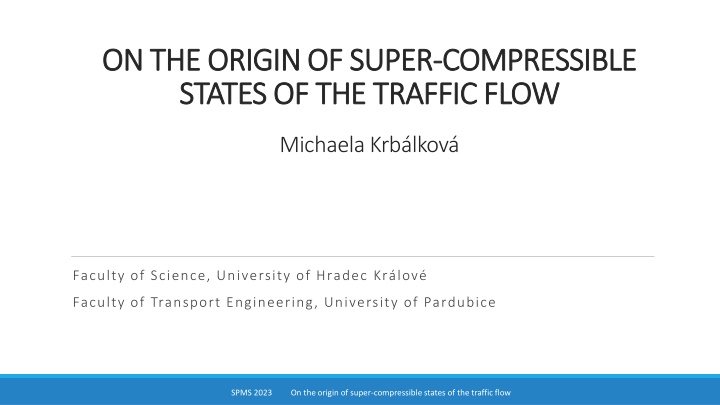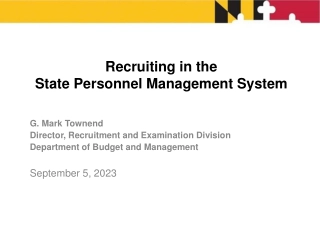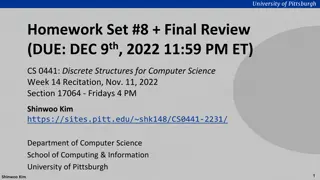
Exploring Super-Compressible Traffic Flow States and Mathematical Framework
Delve into the origin of super-compressible traffic flow states and the conversion of empirical traffic data into a mathematical framework. Discover the analogy between traffic and fluid flow, fundamental diagrams, and microscopic traffic quantities. Uncover the stages of 3S unification for efficient data analysis.
Download Presentation

Please find below an Image/Link to download the presentation.
The content on the website is provided AS IS for your information and personal use only. It may not be sold, licensed, or shared on other websites without obtaining consent from the author. If you encounter any issues during the download, it is possible that the publisher has removed the file from their server.
You are allowed to download the files provided on this website for personal or commercial use, subject to the condition that they are used lawfully. All files are the property of their respective owners.
The content on the website is provided AS IS for your information and personal use only. It may not be sold, licensed, or shared on other websites without obtaining consent from the author.
E N D
Presentation Transcript
ON THE ORIGIN OF SUPER ON THE ORIGIN OF SUPER- -COMPRESSIBLE STATES OF THE TRAFFIC FLOW STATES OF THE TRAFFIC FLOW COMPRESSIBLE Michaela Krb lkov Faculty of Science, University of Hradec Kr lov Faculty of Transport Engineering, University of Pardubice SPMS 2023 On the origin of super-compressible states of the traffic flow
Conversion of empirical traffic data into mathematical framework MACROSCOPIC TRAFFIC QUANTITIES (3 fundamental phase variables) ? ?,? ??(?,?) traffic density: ?? I ?,? ??(?,?) traffic intensity: ?? average velocity: V(?) ? ?,? smoothed number of particles, i.e. number of vehicles in the interval ( ,?) ? 2?? (? ??(?))2 ? 1 ? for Gaussian kernel: ? ?,? = ?=1 2?2 SPMS 2023 On the origin of super-compressible states of the traffic flow
Conversion of empirical traffic data into mathematical framework Analogy between the traffic flow and fluid flow: principle of continuity (= conservation law of number of particles) ?? ??+?? ??= 0 hydrodynamic alternative (for homogenous flow only!) ? ?,? = ? ? ? ?,? SPMS 2023 On the origin of super-compressible states of the traffic flow
Conversion of empirical traffic data into mathematical framework fundamental diagram: graph of the function ? = ? ? or V = ? ? fundamental diagram binary relation ???or ??? SPMS 2023 On the origin of super-compressible states of the traffic flow
Conversion of empirical traffic data into mathematical framework MICROSCOPIC TRAFFIC QUANTITIES primary quantities = directly measured individual velocities ?? lengths of cars ?? time instants ?? (??),?? (???) secondary quantities = derived quantities time headway / time clearance distance headway / distance clearance SPMS 2023 On the origin of super-compressible states of the traffic flow
Conversion of empirical traffic data into mathematical framework 3S UNIFICATION large samples of succeeding vehicles (and their microstructure) shows significant non-homogeneities need to prevent mixing of states with different statistical properties We recognize 3 stages: I. Sampling = division of data into homogeneous samples of several neighboring cars II. Scaling = conversion of each samples to scaled alternative III. Segmentation = selection of samples having specific values of the fundamental variables SPMS 2023 On the origin of super-compressible states of the traffic flow
Mathematical instruments for traffic systems Transition from real traffic system to an appropriate mathematical model: flow of succeeding vehicles in one lane = stochastic ensemble of ordered point-like particles located on a half line with a reference particle (? = 0) positioned at ?0 lengths of vehicles are excluded (i.e. dimensionless particles) number of vehicles ? + one-dimensional stochastic particle system SPMS 2023 On the origin of super-compressible states of the traffic flow
Mathematical Description of 1D Particle System The system is naturally described by three random variables: ?? ??+1 ?? 1) mutual headways ?? ??+1 ?0 2) multi-headways ?? 3) interval frequency SPMS 2023 On the origin of super-compressible states of the traffic flow
Continuous description of 1D Particle System Ad 1) headways (gaps) between succeeding particles ?0,?1,?2, sequence (??)?=0 of non-negative random variables identically distributed via a probability distribution function ? ? of random multi-headways Ad 2) sequence (??)?=0 ?? ?=0 if ?0,?1,?2, independent variables ??~ ?=0 ? ?i ? ? ? GENERATOR of the PS ? ? ~?0,?1,?2, the only mathematical object defining the particle system completely! SPMS 2023 On the origin of super-compressible states of the traffic flow
Continuous description of 1D Particle System PREREQUISITES FOR THE GENERATOR ?(?) generally: arbitrary probability density function of non-negative random variable, i.e. ? ? = ? ? ? , where ??= ???? ? d? R with the complete moment code (??)?=0 traffic system: fundamental fact known at field of traffic = traffic system is short-ranged, resp. middle-ranged i.e. interactions restricted only to a pair of neighboring particles, resp. to a few neighboring particles (? + ) ?(?)~? ??for ? + additional restricting assumption for the generator concept of Balanced Particle Systems: ? ? , where is the family of balanced functions = family of piecewise continuous, integrable, and non-negative functions ? ? having a positive support, for which there exists positive number ? so that: ? ? ? ???= + ? ? ? ???= 0 ? > ? : lim ? < ? lim SPMS 2023 On the origin of super-compressible states of the traffic flow
Discrete description of 1D Particle System Ad 3) interval frequency ?? the number of particles lying in the interval of length ? located immediately beyond the reference particle we explore changes of following quantities depending on value of ?: trending function ? = ? ?? = ?=1 ? ??= ? statistical rigidity (? ?)2 ??= ? ?= ?=0 ?is the linear-like function ? ?? + ? + ? ?2,? + noticeable linear asymptote ? 0 compressibility ? deflection SPMS 2023 On the origin of super-compressible states of the traffic flow
Classification of random systems according to statistical rigidity For typical theoretical or empirical systems (e.g. movement of vehicles on a single lane) 3 categories of stochastic behavior detected: Poisson systems (absolutely random and uncorrelated events) probability that ? particles lies inside ?0;?0+ ? : ??= ? = (?? )?? ??/?! ? ? = ?(?)? ?for the scaled variant of particle/vehicle systems ?= ?, ? = 1 upper bound for all 1D stochastic systems Deterministic systems (absolutely rigid) ?= 0, ? = 0 lower bound for all 1D stochastic systems SPMS 2023 On the origin of super-compressible states of the traffic flow
Classification of random systems according to statistical rigidity Sub-Poissonian states stochastic systems with particles repulsed by inter-particles forces Super-Poissonian states their statistical fluctuations exceed fluctuations observed in systems with totally independent events very rare! DIFFERENT CLASSIFICATION: Uni-compressible systems: ? = 1 Sub-compressible systems: 0 < ? < 1 Super-compressible systems: ? > 1 SPMS 2023 On the origin of super-compressible states of the traffic flow
Graphs of the statistical rigidity analyzed for several pedestrian experiments. The gray zone shows a region of vehicular rigidities, i.e. empirical statistical rigidity detected for vehicular traffic is usually a curve lying in this zone. SPMS 2023 On the origin of super-compressible states of the traffic flow
Statistical analysis of empirical traffic data EMPIRICAL DATA traffic data collected during 90 days at freeway circuit R1, Prague (the main lane and fast lane) 3S-UNIFICATION PROCEDURE density band = ?,? + 5 ?? /?? -> data sub-samples (sampling size 50) -adjoint set of traffic micro-quantities -> course of statistical rigidity, i.e. value of compressibility ? changing the traffic density ? -> dependency ? = ? ? RESULTS main lane: sub-compressible states (for all segments ? < ?) fast lane: for congested traffic phase (? > 25 ?? /??) we detect the sub-compressible states (? < ?) for free flows we detect the super-compressible states (? > ?) SPMS 2023 On the origin of super-compressible states of the traffic flow
Statistical rigidity of freeway data for the selected segments VDin a main lane. Vehicle-by-vehicle data have been collected during 90 days at freeway circuit R1 (located near Prague, Czech Republic) by technology of induction double-loop detection. Specifically: a) VD= [5, 6] [100, 115], b) VD = [15, 17] [100, 115], c) VD = [20, 22] [90, 105], d) VD = [25, 27] [80, 100], e) VD= [30, 32] [10, 80], f) VD= [40, 45] [10, 80], g) VD= [60, 65] [10, 80]. [units: veh/km km/h] SPMS 2023 On the origin of super-compressible states of the traffic flow
Statistical rigidity of freeway data in a fast-lane traffic flow. Data visualized have been extracted from the same segments as those mentioned above. SPMS 2023 On the origin of super-compressible states of the traffic flow
Origin of super-compressible states? headway distribution in general short-ranged vehicular streams: g ? = ??(?)? ?? ? ?? ? 0 stochastic resistivity (inverse thermodynamic temperature) ? ? potential associated with the force description ? ? = ? ? : ? ? ?1(0,+ ), lim ? 0+? ? = , lim ? ? = 0 ? + theoretically proven fact in physics of traffic (M. Krb lek, F. eba, M. Krb lkov , Super-random states in vehicular traffic Detection & explanation, Physica A 585 (2022) 126418): All particle systems with a purely repulsive interaction (i.e. ? ? = ? ? > 0) where, in addition, for the resistivity it holds ? > 0, are sub-compressible, since the associate compressibility is ? < 1. For creating a super-compressible ensembles (with ? > 1), the particle interactions must also include an attractive component. SPMS 2023 On the origin of super-compressible states of the traffic flow
Possible reasoning of super-compressiblefeatures 1. VEHICLES CHANGING THE LANES flow at lower densities -> inhomogeneous division of vehicles into two lanes (sporty driving vs. moderate driving) result of overtaking maneuvers vehicular bunching 2. CHARACTERISTIC TRAIT OF DRIVERS super-compressible states are detected in fast lane only! (empirical data) another possible reasoning? -> personality of the driver (competitiveness generating the attractive forces) SPMS 2023 On the origin of super-compressible states of the traffic flow
Summary Real traffic system shows very rare super-compressible states under certain circumstances (free flow, fast lane). Super-compressible states -> the particle interactions must also include an attractive component. Possible reasoning of super-compressible features (and the attractive component): vehicles changing the lanes characteristic trait of drivers What method can be used to decide which explanation is correct? by using new data records, when main lane and fast lane are separated (due to reconstruction works on freeways) changing the lanes is not possible NEW SUBJECT TO RESEARCH SPMS 2023 On the origin of super-compressible states of the traffic flow
THANK THANK YOU YOU! ! SPMS 2023 On the origin of super-compressible states of the traffic flow




















